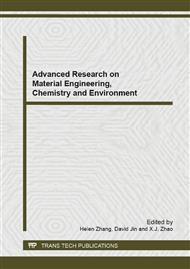p.7
p.11
p.15
p.19
p.23
p.27
p.31
p.34
p.38
Resonance Rayleigh Scattering Spectral Determination of As(V) Using Cu(II) as Catalyst
Abstract:
In HCl medium and in the presence of CuSO4, Na3AsO4 can be reduced by NaH2PO2 to form As nanoparticles (AsNs) which exhibited a strong resonance Rayleigh scattering (RRS) peak at 370 nm. Under the chosen conditions, the increased intensity at 370 nm was linear to As5+ concentration in the range of 0.48-38.0×10-6 mol/L, with a regression equation of ΔI370nm = 82.3 CAs + 33.9, a correlation coefficient of 0.9878 and a detection limit of 2.0×10-7 mol/L As5+. The proposed method was applied to detect As5+ concentration in waste water, with simplicity, rapidity and accuracy. Thus, a novel RRS spectral method was established to determine As5+.
Info:
Periodical:
Pages:
23-26
Citation:
Online since:
September 2013
Authors:
Keywords:
Price:
Сopyright:
© 2013 Trans Tech Publications Ltd. All Rights Reserved
Share:
Citation:


